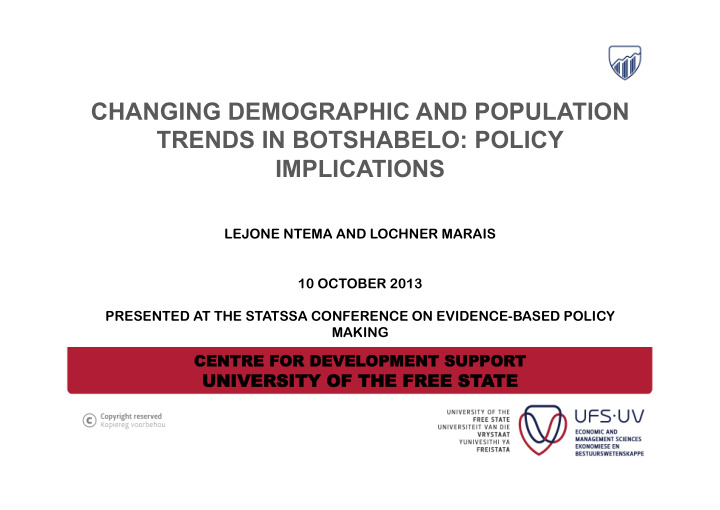



CHANGING DEMOGRAPHIC AND POPULATION TRENDS IN BOTSHABELO: POLICY IMPLICATIONS LEJONE NTEMA AND LOCHNER MARAIS 10 OCTOBER 2013 PRESENTED AT THE STATSSA CONFERENCE ON EVIDENCE-BASED POLICY MAKING CE EN NT TR RE E F FO OR R D DE EV VE EL LO OP PM ME EN NT T S SU UP PP PO OR RT T U UN NI IV VE ER RS SI IT TY Y O OF F T TH HE E F FR RE EE E S ST TA AT TE E
BACKGROUND • ! Botshabelo was created by apartheid policies • ! As a strategy to ensure displacement of black urbanisation to areas behind “homeland” boundaries • ! Settlements commonly known as hidden urbanities (functionally urban but located away from the functional urban areas) • ! Typical example of fragmented apartheid planning
POPULATION SIZE IN BOTSHABELO !"#$% &'()*#+',%-,.% /,,)#*%0$'123%$#2"% 45,6"%($"75')4%8"#$% !"#"$ %#&'''$ !"('$ )'&'''$ !"(*$ !+"&+'*$ !*,#$ !""!$ !##&"%)$ %,($ !"")$ !##&")"$ ','$ %''!$ !#*&)#%$ -',.$ %'!!$ !*!&(*.$ -!,+$
AVERAGE AGE FOR BOTSHABELO POPULATION /012$ 3402150$$350$ !"(($ !($ !""!$ %'$ !"")$6789:1;0<7$ =>4098?0>8$@8ABC$ %+,*$ !"")$D0>9A9$ %.$ %''!$D0>9A9$ %*,($ %'!!$D0>9A9$ %#,!$
MALE / FEMALE RATIO !"#$% 9%:";#*"% 9%<#*"% 9%:";#*"% 3"#="=% 3')4"3'*=4% !""!$ *.$ +#$ !"")$D0>9A9$ !"")$6=@$ *+,%$ +*,($ .!$ %''!$ *.,#$ +),.$ +#$ %'!!$ *.,!$ +),"$ +),)$
AGE DISTRIBUTION OF BOTSHABELO POPULATION /0"% >??@% ABB>% AB>>% 6#2"0'$8% $E>F$ EGF$ $E>F$ EGF$ $E>F$ EGF$ !!,"$ %*&'*($ !+,%$ %'&#(($ %'&"%'$ !.,($ H)$ !#,+$ %"&!!#$ !),)$ .'&*..$ %!&'#+$ !.,($ )-!%$ !!,)$ %!&%#'$ !%,!$ %'&.#%$ !*&*.!$ !',%$ !.-!#$ %%,"$ +%&!+.$ %.,"$ +'&%#)$ .)&*%!$ %+,!$ !(-%"$ !+,%$ %+&#..$ !+$ %*&'%)$ !(&#(#$ !%,.$ .'-."$ ","$ !+&"#+$ (,*$ !#&.#.$ !*&+'#$ !',%$ +'-+"$ *,*$ (&+')$ +,($ "&#!+$ !!&('"$ #,"$ *'-*"$ %,'$ .&+'"$ !,"$ .&++($ +&'!#$ %,)$ )'-)+$ +,)$ #!!"$ +,'$ (!+%$ #&#(%$ *,!$ )*I$
WATER ACCESS TO HOUSEHOLDS IN BOTSHABELO >??@% ABB>% AB>>% J02K0>8150$7L$:7A90:7<B9$ MN8:$M1802$N>$:7A90$ !),)$ +,)$ .',#$ J02K0>8150$7L$:7A90:7<B9$ MN8:$M1802$7>$981>B$ %+,($ *),*$ )),)$ J02K0>8150$7L$:7A90:7<B9$ MN8:$M1802$MN8:N>$%''?$ L27?$981>B$ *(,'$ !(,+$ !,+$ O8:02$ '$,)$ %',+$ !,.$
SANITATION SERVICES PER HOUSEHOLDS >??@% ABB>% AB>>% • ! 1996 P<A9:$Q7N<08$ #,.$ #,.$ .",*$ R=J$ *.,.$ +(,.$ **,"$ 6AKS08$ .!,+$ .%,.$ %,.$ T7>0$ #,)$ ",.$ !,.$ O8:02$ ',+$ %,($ !,'$
NUMBER OF ROOMS PER HOUSE !"#$% /7"$#0"%,);C"$%'D%$'';4% ("$%3')4"% !"")$ .,'%$ %''!$ .,.($ %'!!$ +,!%$
TYPE OF HOUSING UNITS >??@% ABB>% AB>>% P72?1<$:7A9N>5$A>N8$ *(,+$ )%,!$ (+,.$ =>L72?1<$:7A9N>5$A>N89$ .%,+$ %),)$ !+,'$
INTERNAL MIGRATION IN BOTSHABELO • ! South to north (combination of factors) • ! Schools closing down – especially the south part of Botshabelo
INDUSTRY IN BOTSHABELO • ! Manufacturing sector is dominant in Botshabelo’s industrial area • ! Currently contributing 35% to the economic development of the Botshaeblo’s industrial area • ! In terms of occupancy levels of industrial sites in this area-there was a decline in the past three years • ! The current occupancy level is 80%
CONCLUSION • ! Increased access to services • ! Increased housing investment • ! Declining population • ! Declining school population • ! School closures • ! The intention of various IDPs to grow the Botshabelo economy and to invest in Botshabelo • ! Declining occupancy levels in the industrial area • ! How does one reconcile the above?
CONTINUED.... • ! Despite improved infrastructure and significant housing investment there is a continued outflow of school going and working age people • ! What does this mean for future planning?
Recommend
More recommend